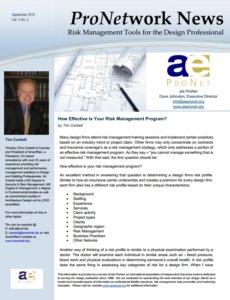 Many design firms attend risk management training sessions and implement certain practices based on an industry trend or project claim. Other firms may only concentrate on contracts and insurance coverage’s as a risk management strategy, which only addresses a portion of an effective risk management program. As they say – “you cannot manage something that is not measured.” With that said, the first question should be:
Many design firms attend risk management training sessions and implement certain practices based on an industry trend or project claim. Other firms may only concentrate on contracts and insurance coverage’s as a risk management strategy, which only addresses a portion of an effective risk management program. As they say – “you cannot manage something that is not measured.” With that said, the first question should be:
How effective is your risk management program?
An excellent method in answering that question is determining a design firms risk profile. Similar to how an insurance carrier underwrites and creates a premium for every design firm, each firm also has a different risk profile based on their unique characteristics:
• Background
• Staffing
• Experience
• Services
• Claim activity
• Project types
• Clients
• Geographic region
• Risk Management
• Business Practices
• Other features
Another way of thinking of a risk profile is similar to a physical examination performed by a doctor. The doctor will examine each individual in similar areas such as – blood pressure, blood work and physical evaluations in determining someone’s overall health. A risk profile does the same thing in assessing key categories of risk for a design firm. When I have evaluated “higher performing design firms” the first step they apply is an assessment. With this information, higher performers make decisions for improved performance and risk reduction to ensure effective practices are applied for meeting the business needs of the firm, clients, and projects.
Industry Risk and Relevance to Your Firm
One important point for managing risk is assessing the softer side of a design firms practice – business and practice management efforts. These areas routinely drive a majority of claims and litigation against design firms, approximately 60 – 75%. Do all design firms apply the same business and practice management efforts? Obviously the answer is no. Design firms apply various methods, techniques, practices, etc., with some more effective than others. With that said, a one-size fits all risk management approach is not very effective in addressing the specific needs of any design firm. Continue reading “How Effective is Your Risk Management Program?”











